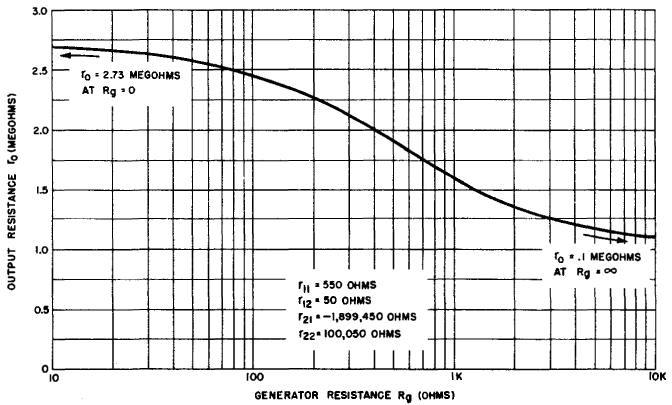| Transistor Basics is a free introductory textbook on transistors and their basic applications. See the editorial for more information.... |

|

Home  Grounded Emitter and Grounded Collector Transistors Grounded Emitter and Grounded Collector Transistors  The Grounded Emitter Connection The Grounded Emitter Connection  Output Resistance Output Resistance |
|||






|
|||
|
Output Resistance for the Grounded Emitter ConnectioAuthor: Leonard Krugman The output resistance was defined by equation 3-21 in terms of the general four-terminal parameters as:
The output resistance in terms of the internal transistor parameters in the grounded emitter connection becomes:
Fig. 4-5. Output resistance vs generator resistance for typical point-contact transistor (grounded emitter). The effect of the value of the signal generator resistance is illustrated for the point-contact and junction transistors in Figs. 4-5 and 4-6, respectively. Notice that the output resistance of the point-contact type is positive at Rg = 0, and decreases rapidly to zero when Rg is slightly less than 50 ohms. As Rg is increased further, ro becomes negative and gradually approaches the limiting condition, when Rg is infinite, r1 = r22 = -11,850 ohms. Thus, the point-contact transistor can have a negative output resistance over a large range of generator resistance values, and this characteristic can be used in transistor oscillator design. Circuits of this type are called "base-controlled oscillators."
Fig. 4-6. Output resistance vs generator resistance for typical junction transistor (grounded emitter). The output resistance of the junction transistor is always positive, and for the typical type considered, ro gradually decreases from approximately 273,000 ohms to 100,000 ohms as Rg is increased from zero to infinity. The range in which both the output and input resistances of the point-contact transistor are positive can be increased by adding external resistance in the emitter arm. This increases the effective value of re = r12. Notice that if enough external resistance is added so that the effective emitter resistance re + RL is equal to or greater than -(rc - rm), the input and output resistance is positive. This stabilizing effect of adding resistance to the emitter load is frequently used in transistor circuit applications.
|
|||
Home  Grounded Emitter and Grounded Collector Transistors Grounded Emitter and Grounded Collector Transistors  The Grounded Emitter Connection The Grounded Emitter Connection  Output Resistance Output Resistance |
|||
Last Update: 2007-07-12





